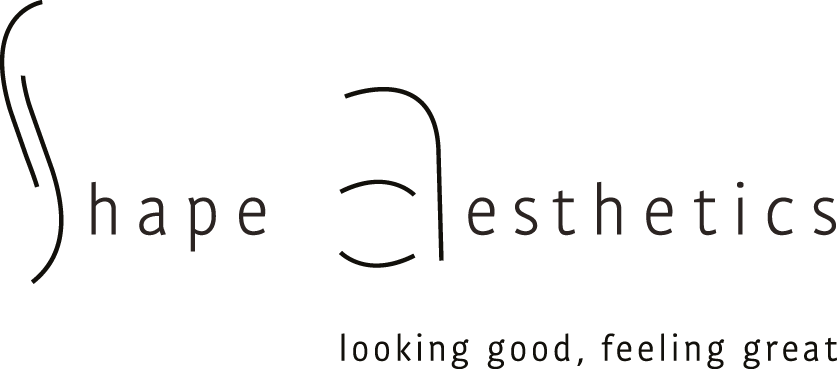Varicose veins/Varices
The venous system of the legs consists of the superficial and the deep system. The superficial system is a network of many vessels surrounding the leg. The superficial system collects 10-20% of the blood in the tribal veins or the vena saphena Magna (VSM) and the vena saphena parva (VSP). The deep system is located in the leg muscles and when walking, the calf muscles contract, squeezing the veins empty. It is also referred to as a “calf muscle pump”. This system provides more than 80% of the blood flow from the legs.
Normally, the valves in the veins prevent the blood from backing down. When the valves do not close properly, the blood flows less well and there is more pressure on the vein. This causes the vein to stretch and widen. Due to the increased pressure on the vein, more and more valves will close poorly and eventually this will become visible as varicose veins. Varicose veins are more common in women than in men. The medical term for varicose veins is varicose veins.
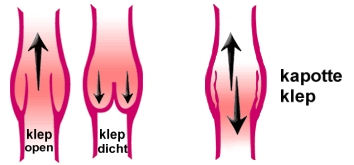
ORIGIN:
Various factors influence the development of varicose veins.
Heredity: Varicose veins are often hereditary. Varicose veins can develop due to congenital weakness of the supporting tissue of the veins. In rare cases, there are too few or no valves in the leg veins.
Zwaartekracht: Doordat de mens rechtop loopt zullen onder invloed van de zwaartekracht spataderen zich juist in de onderbenen gaan ontwikkelen. Tall people and people with a standing profession are more likely to develop varicose veins for this reason.
Pregnancy and hormonal influences: Both hormonal influences and a restriction of the backflow of blood in the veins from the legs to the heart (due to pressure from the growing uterus) make varicose veins more likely to develop during pregnancy. The exact influence of the various hormones on the development of varicose veins is not yet entirely clear, but seems to be present.
Thrombosis leg: Varicose veins can also be a result of a disease such as a thrombosis leg. In a thrombosis leg, some veins inside the leg have become blocked by clotted blood. As a result, other veins on the outside of the leg are overloaded. After a number of years, many people who have had a thrombosis leg will suffer from varicose veins as a result.
Overweight: Overweight makes varicose veins more common.
Other leg disorders: Inflammation of the veins (= thrombophlebitis), operations and accidents can lead to varicose veins, because the valves are damaged and therefore no longer work properly.
WHAT ARE THE COMPLAINTS:
In general, the blue thickened or palpable veins are often experienced as disturbing. If the varicose veins cause complaints, it is in the form of a heavy, sluggish feeling in the legs. These complaints increase during the day, in hot weather and when standing for a long time. Sometimes one has fluid in the legs, itching, tingling or one cannot keep the legs still in bed (restless legs) or nocturnal calf cramps. In rare cases, there is pain or bleeding from a varicose vein. Due to the improper flow of blood back to the heart, fluid accumulation (oedema) occurs around the ankles and eventually eczema, pigment formation, hardening of the skin and finally an open leg (ulcus cruris venosum) can develop.
DIAGNOSIS VARICOSE VEIN:
By means of a duplex device, leaking valves are made visible on a monitor using sound waves. This examination or phlebodiagnostics is painless. The purpose of the examination is to determine whether a varicose vein can be treated and what type of treatment can be chosen. In addition to verbal explanations, you will receive written information about the chosen treatment.
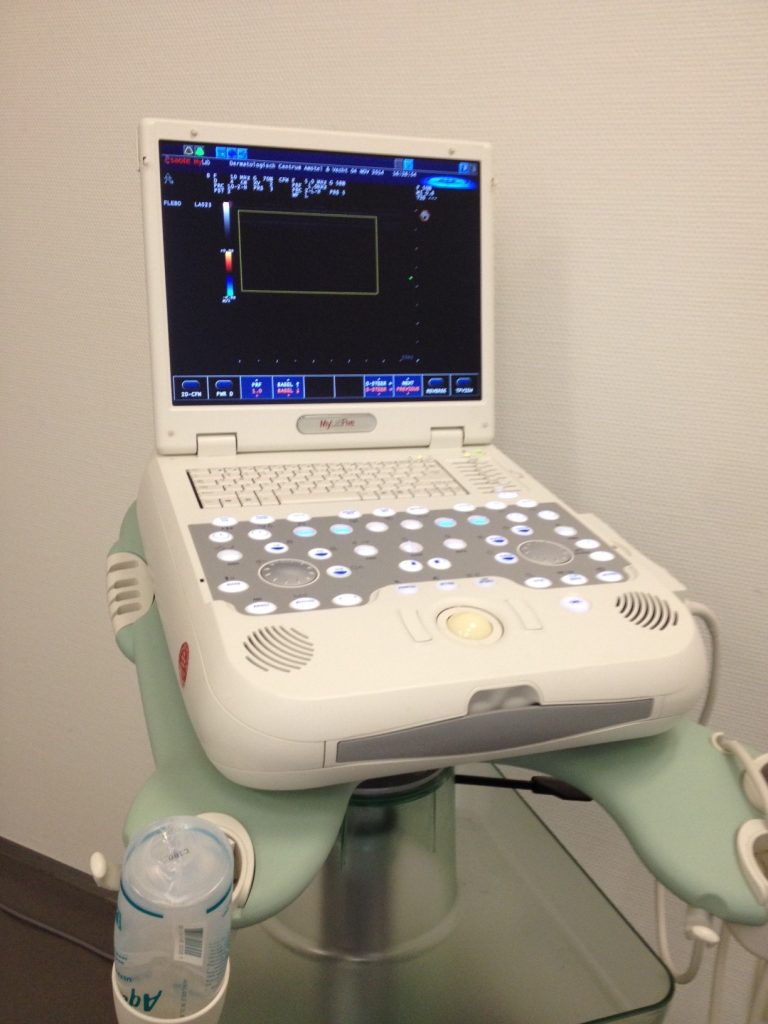
TREATMENT:
If only small varicose veins are present then ‘spraying away’ or sclerosing is the best solution. If only small varicose veins are present then ‘spraying away’ or sclerosing is the best solution.
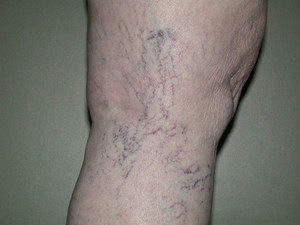
According to Müller, sclerosing or ambulatory phlebectomy is the best option for medium-sized vessels.
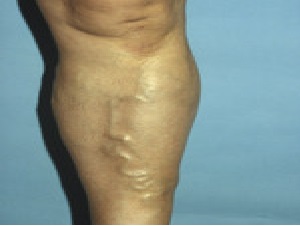
For treatment of very large vessels, it is best to cauterize it internally (endovenous treatment with the VNUS method).
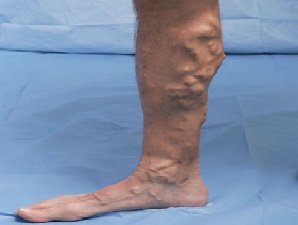
OVERVIEW OF TREATMENTS:
This is a treatment in which the blood flow is promoted as much as possible by means of external pressure (for example bandages or elastic stockings). For the measurement of an elastic stocking, you can go to a stocking specialist or a bandagist in your area.
In this form of treatment, a thin tube is inserted into an internal varicose vein through a small insertion opening in the leg. In the VNUS method, the vein is cauterized with radiofrequency energy. The treatment is performed under local anesthesia and under sterile conditions. After the treatment you should wear an elastic stocking for 2-3 weeks. You can immediately resume your daily activities. Sports are not allowed for two weeks. Pain complaints after treatment are rarely observed. Bruising, tenderness and swelling of the treated varicose vein are occasionally seen. Due to the higher effectiveness and lower number of side effects of these two methods compared to surgical methods, operations are performed less and less these days.
You should not be treated with fillers if you are pregnant and/or breastfeeding or if you are under 18 years old. If you have other filling material at the treatment site, you should also not be treated with the hyaluronic acid-based filler. Finally, the treatment is not recommended if you suffer from active herpes simplex (cold sores).
The ambulatory phlebectomy according to Müller (also known as “Müller”) is mainly done for varicose veins of a large side branch or for varicose veins that run on the back of the foot or over the knee. Important advantages are that the therapy is performed under local anesthesia and that healing occurs quickly after the treatment. Under local anesthesia, small incisions (cuts) of 1-2 mm are made in the skin above the vein. The barrel is pulled out in pieces through these small holes with a hook. This treatment has the greatest chance of lasting results with rapid healing. The disadvantage is that a relatively limited length of vessel can be treated per treatment. After the treatment you should wear a long stocking for at least 1 week.
During sclerosing, a liquid (= polidocanol) is injected into the varicose veins, after which the blood vessel wall adheres. The varicose vein turns into a scarred strand after a few weeks, so that no blood can flow. The other blood vessels take over the function.
Often a combination of different techniques is used to obtain the best result. You can miss the ‘treated’ barrels because the barrels are not working properly. Untreated varicose veins can even cause long-term problems such as fluid retention, eczema, vascular inflammation, skin changes and even leg ulcers.
OUTLOOK:
The cause of varicose veins and size more or less determines the success of the treatment. In one person the varicose veins come back quickly, in another they stay away for years. However, a new varicose vein can develop elsewhere in the venous system.
